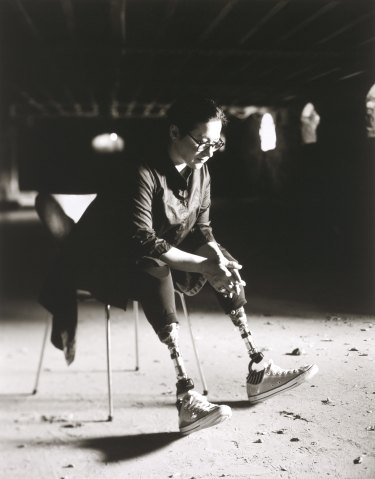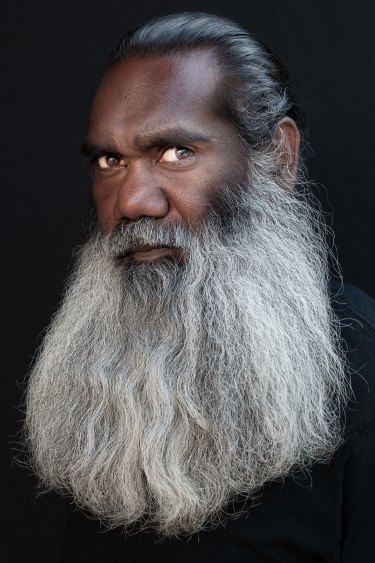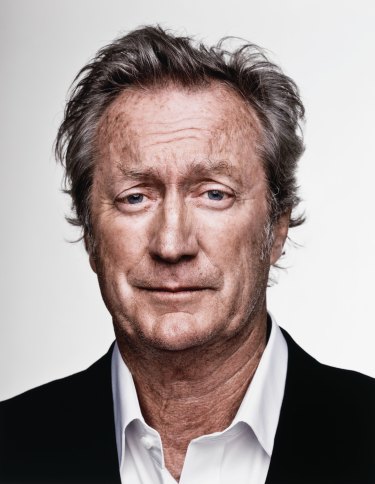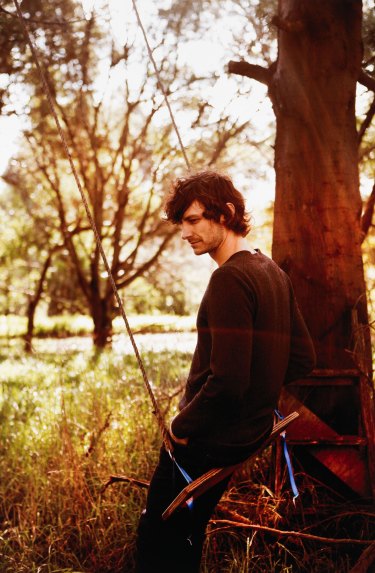Because her portrait features in the exhibition The Look, Gill Hicks was immediately spotted by front desk staff when she arrived one day last year to see the show at Canberra’s National Portrait Gallery. Hicks, the well-known peace advocate, became a double-amputee when she lost both legs below the knee in the 2005 London Underground bombings.
On that gallery visit, as she chatted with the staff, Hicks says she felt a rush of emotion. They told her several school groups had been through, and all the children had talked about the Hicks portrait, taken in 2016 by Tony Kearney. Why? Because in the photo, Hicks is wearing Converse.
“It set me off,” Hicks says. “What it got me thinking about was this sense of connection – you see things that are like yourself.” And all the children, of course, related to the sneakers. “They didn’t see the disability.”
Gill Hicks 2016. Inkjet print. National Portrait Gallery, CanberraCredit:Tony Kearney
Portraiture is all about connections: between the sitter and the portrait-maker, and between the finished portrait and those who view it. When The Look (opening March 7 at Geelong Art Gallery) was unveiled, one of its curators, Joanna Gilmour, was fascinated by how the 60-plus images of Australians help to recast the very idea of portraiture – one of the most ancient forms of art-making, but most popular in photographic form since the dawn of the 20th century.
The Look is all photography – which makes sense when the NPG director, Karen Quinlan, explains that contemporary photographs make up more than half of the gallery’s 3000-strong collection. Contemplating images from the gritty to the glossy, from smiling faces to troubled or defiant ones, we scrutinise up close many well-known faces (from Rachel Griffiths, Heath Ledger, Archie Roach and Cate Blanchett to Bryan Brown, Marcia Langton, Nicole Kidman and Helen Garner) to lesser-known people, all of whom fall into a broad “Australian achievement” category.
And all the while we wonder: what is it about portraiture – especially photography – that is so intriguing? Is it that we feel we can see the “real” person below their veneer of fame and glory?
Looking at her portrait, in which she gazes downwards thoughtfully, Hicks considers these ideas about identity. “Tony has captured something that is really quite remarkable, almost like a deep contemplation,” she says. “But you don’t see the legs as the first thing in that piece – you see someone who is deeply contemplative. And then it’s ‘Oh, they are two prostheses where the legs are!’ It is quite captivating for that reason.”
You don’t see the legs as the first thing in that piece – you see someone who is deeply contemplative. And then it’s ‘Oh, they are two prostheses where the legs are!’ It is quite captivating for that reason.
For Kearney, the man who took Hicks’ photo, one of the challenges of the afternoon they spent at an old rat-infested, disused wool shed in Port Adelaide was working with the low light (which he relishes). Hicks, he says, had been having a bad day with pain caused by her prostheses, so he had her sit down and take it easy.
“She sat there very quietly and still,” he says. “As I took the photos, we were discussing all sorts of things along the way, including the horror of her experiences in London. She is an extraordinary person.” And that is evident in the image we see in The Look.
In her book Portraits and Persons: A philosophical inquiry, US art writer Cynthia Freeland suggests that while the goal of portraiture seems strange – to create an inanimate object/image that purports to represent a person’s distinctive soul, essence or “air” – there is certainly something mysterious about portraits, and we gravitate towards that enigma. Often, she writes, portraits depict people in a way that makes them look amazingly alive and present – and they often seem to look directly back at us.
Exploring the diverse array of portraits in The Look – including actors, sportspeople, models, musicians, activists, academics, artists, a chef, choreographer, racing-car driver and even some Play School presenters – we might ruminate on Freeland’s proposition that portraiture explores issues such as the inner versus the outer self, as well as the very definition of self. How, Freeland asks, do “alchemist” portrait artists succeed in their project to make their sitters appear alive with psychological awareness, consciousness and an inner emotional life?
The two curators for The Look, Gilmour and her former colleague Sarah Engledow, are thoughtful on these points. Gilmour says the show is an opportunity to dismantle perceptions about portraiture as being “boring old paintings in boardrooms and town halls” or “august, stuffy, elitist” institutions. “This exhibition is a way of celebrating that portraiture can be a sexy, fun, surprising genre.”
She reckons the sitters are unified in being distinctly themselves and comfortable in their own skins when captured by their various photographers (many of whom are stars in their own right). And Engledow, writing in The Look catalogue, observes that the word “look” operates as both verb and noun in the show: there is the way the portrait sitters look us in the eye as we look back; and there is the “look” or attitude they adopt – come-hither, quizzical, enigmatic or melting.
“If you’re an actor, you can turn on a look of nonchalant heat, like Heath Ledger; a doubtful look, like Rose Byrne; or a sceptical look like Bryan Brown,” she writes.
The Look grew out of a two-pronged idea: to demonstrate the possibilities for the portraiture genre and, simultaneously, to display a cross-section of the best contemporary photos in the NPG collection. That cross-section inevitably means there is a diversity of ages, cultures, vocations and demographics in the photos on show.
There is also a great breadth of time stretching from Noni Hazelhurst (1977 Lorrie Graham) and Edmund Capon (1986 Neil Duncan) to Gary Ede’s portraits of The Saints (1978) and Steve Kilbey (1981), to Michael Hutchence (1997 Harry Borden) and Russell Page (1998 Tracey Moffatt), right up to the present.
“It is the whole NPG collection in microcosm,” Gilmour says. This ranges from a “very conscious projection of look”, such as the Maggie Tabberer portrait (2015 Alana Landsberry) to something more casual – Petrina Hicks’ magnificently direct 2008 portrait of surfer Layne Beachley. There is also a suite of gently piercing portraits from the Michael Riley portfolio, and an “intimate, unconscious moment” photographed by Brett Canet-Gibson in 1998 – a 15-year-old Ian Thorpe moments before the race in which he became the world’s youngest-ever swimming world champion.
As with his Thorpe photo, Canet-Gibson usually shoots against a black backdrop, and usually outdoors, and he is well-known for taking weekly, random streetside portraits of passersby, whom he invites to go before the lens. Among his many stunning images is one taken in 2016 of Indigenous performer Trevor Jamieson. It won the people’s choice award for the NPG’s National Photographic Portrait Prize in 2017.
Trevor Jamieson, 2016. Inkjet print. National Portrait Gallery, CanberraCredit:Brett Canet-Gibson
Little wonder: the image is arresting for its brilliant clarity. Jamieson might be there in the flesh, so direct is his gaze and so detailed his immense beard. A WA actor, dancer and musician, Jamieson was performing on the day Canet-Gibson arranged to photograph him. They went outside, Jamieson stood there and, Canet-Gibson says, he seemed to project out of himself towards the camera. “As soon as I got him in front of the camera it was on,” he says. “He is just magnetic. It is just one of those portraits you shoot, and you just know it has worked. Some people transcend themselves, and Trevor is one of them. He is so comfortable on stage and he has a certain … energy he gives off. My thing is to try and get out of the way of the portrait.”
Adam Knott had heard all about the energy of his famous sitter-to-be, Bryan Brown: don’t waste his time, he was told, because he can be prickly. Knott has had a stunning career shooting celebrity portraits for premier magazines in Los Angeles, New York and Australia, but he was still nervous about taking Brown’s photo in 2008.
“Celebrities are busy people,” Knott says. “I was told by his people not to waste any time, just do the job and get going. He is a living legend, a bit of an icon – and when you meet your heroes, you want to impress. Or at least not upset them.”
The moment arrived and Brown walked straight up to Knott in the studio and said: “OK, mate, what are we doing?” Knott ran him through the process: the photographer had organised three different set-ups and he would shoot Brown in each one, quick as he could. Brown then went off to make-up and the stylists for 45 minutes, returned, and was put through the scenes by Knott.
Bryan Brown 2008. Inkjet print. National Portrait Gallery, CanberraCredit:Adam Knott
“We moved along like a speeding freight train,” Knott says. “It was just him, myself and the studio – his people had gone off. On the third set, I said ‘That’s it, Bryan, we’ve got it’. He was like, ‘You’re kidding’.”
After leaving the set to have his make-up removed, Brown returned and, in front of all the minders, stylists and other staff, said to Knott: “I bloody love you mate.”
“I said ‘Why?’ He said ‘Mate, you are so fast and so good, and now I can go and have lunch with my daughter. You don’t know how much that means to me.’ He shook my hand and that was it, he was gone.”
Julian Kingma was far more leisurely when he did portraits of musician Gotye (“Wally” Wouter De Backer) in 2013. The pair visited De Backer’s parents’ Mornington Peninsula farm and in the soft light of morning moved about among the trees taking snaps.
Wally (Wouter) De Backer 2013. National Portrait Gallery, CanberraCredit:Julian Kingma
“We were just walking around chatting,” says Kingma, a former Sunday Age photographer. “It was a combination of a great spot and nice light. I am a quiet photographer and he is quite a solitary, thoughtful person, so I made it about that. It was nothing spectacular I did – I was in the right spot.”
But, as Kingma says, he shoots his photos quickly and instinctually – and that means the suggestion that we are seeing somewhat into the soul of the subject certainly comes through.
Can portraiture really do that? Hicks seems to think so. Her traumatic experiences in nearly losing her life in the London bombings have perhaps enhanced her appreciation of human experience. In The Look portraits, she is pleased to see so much evidence of human imperfections such as laughter lines and wrinkles, rather than flawless beauty.
“There is something to be seen in all of us that is unique – and that uniqueness can perhaps be the beauty,” she says. “I talk to my daughter about how you see the beauty in someone else, and how somehow that beauty is beamed to the outside by something deep within.
“Yet we are all so desperate to erase our journey, when perhaps one of the most remarkable things about us humans is ‘I’ve seen stuff, I’ve lived!’ [The lined face] shows we’ve got some wisdom.
“Actual beauty can be seen in these faces. How could you ever Botox that away?”
The Look is at Geelong Art Gallery March 7-May 3. geelonggallery.org.au
Source: Read Full Article



